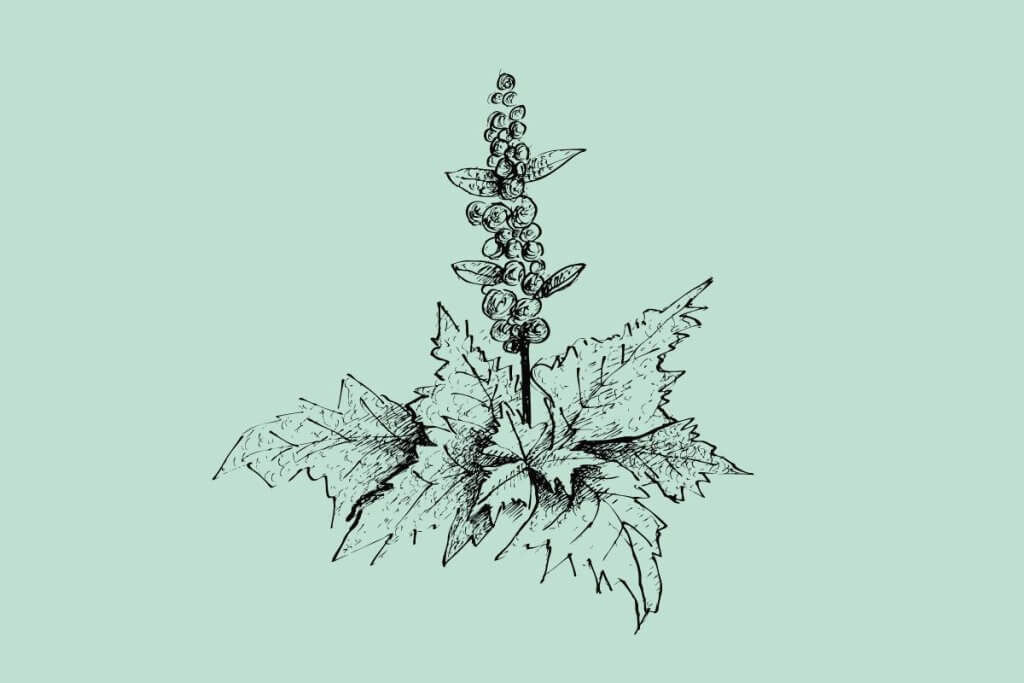Lamb's quarters (Chenopodium album) is a common edible plant that belongs to the amaranth family (Amaranthaceae). It's also known by various other names, including pigweed, white goosefoot, and wild spinach. Lamb's quarters is considered a weed in many regions but is also valued as an edible and nutritious plant.
What kind of plant is lamb’s quarters?
Lamb’s quarters is considered both a weed and wild food.
It belongs to the amaranth family, Amaranthaceae. It is an annual herbaceous plant that is commonly found in various regions around the world.
What are some other names for lamb’s quarters?
Here are some common names for lamb’s quarters:
What Are You Foraging For Right Now?
We're thrilled to hear your ideas. What would you like to submit today? Feel free to share your thoughts and experiences with us.
- Pigweed: This is one of the most widely used alternative names for lamb’s quarters. It refers to the fact that the plant is often considered a weed, and it can be a nuisance in agricultural fields.
- White Goosefoot: The term “goosefoot” refers to the shape of the leaves, which can resemble a goose’s foot. “White” likely refers to the color of the plant’s foliage.
- Wild Spinach: This name highlights the culinary use of lamb’s quarters. The young leaves are often used as a substitute for spinach in cooking.
- Chenopodium: This is the scientific genus name for the plant, which is often used informally.
- Wild Quinoa: Some people refer to lamb’s quarters as “wild quinoa” due to its botanical relationship with cultivated quinoa (Chenopodium quinoa).
- Mexican Spinach: In some regions, lamb’s quarters is known as Mexican spinach.
- Kettle Bottoms: This name is used in certain areas, particularly in the Appalachian region of the United States.
- Fat Hen: This name is more commonly used in Europe and refers to the plant’s tendency to grow in nutrient-rich soils.
Why is it called Lamb’s Quarters?
The name is believed to be derived from the shape of the leaves, which are often triangular or diamond-shaped and somewhat resemble the shape of a lamb’s quarter (or leg).
The term “quarters” in this context refers to a segment or part, similar to how the term might be used to describe a quarter of a circle or a quarter of a piece of paper. The “lamb’s quarters” name highlights the distinct shape of the plant’s leaves.
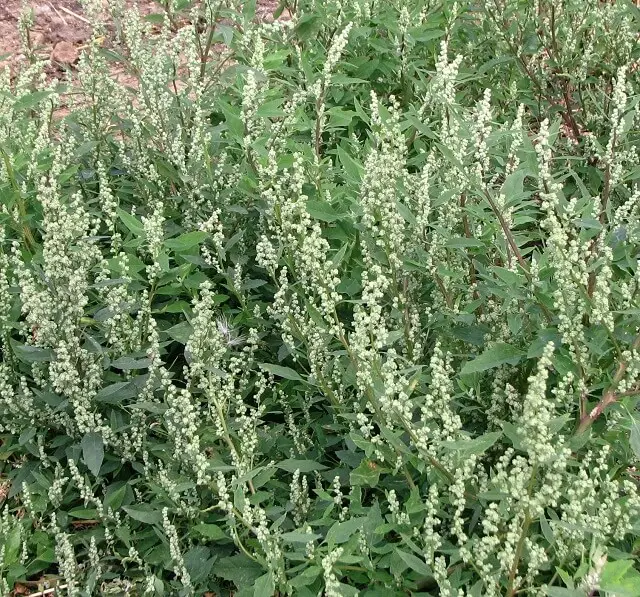
How do you identify lamb’s quarters?
The key characteristics to look for when identifying lamb’s quarters include:
1. Leaf Shape and Color:
- Lamb’s quarters leaves are generally triangular to diamond-shaped, and they can vary in size.
- The leaves are often gray-green on the underside and have a slightly mealy or powdery texture.
- The margins of the leaves are usually toothed or lobed, with a wavy or slightly scalloped edge.
2. Leaf Arrangement:
- The leaves are arranged alternately along the stems.
3. Stem and Growth Habit:
- The stems of lamb’s quarters can be somewhat erect and may branch out.
- The plant can reach a height of 3 to 6 feet (1 to 2 meters) or more, depending on the growing conditions.
4. Flower and Seed Structure:
- Lamb’s quarters produce small, inconspicuous green flowers that are clustered in dense spikes.
- The flowers eventually give rise to seeds, which are tiny and round.
6. Mealy Texture:
- Rubbing the leaves between your fingers might give you a slightly mealy or powdery feeling due to the texture of the plant’s surface.
7. Growth Pattern:
- Lamb’s quarters tend to have a bushy or somewhat sprawling growth pattern.
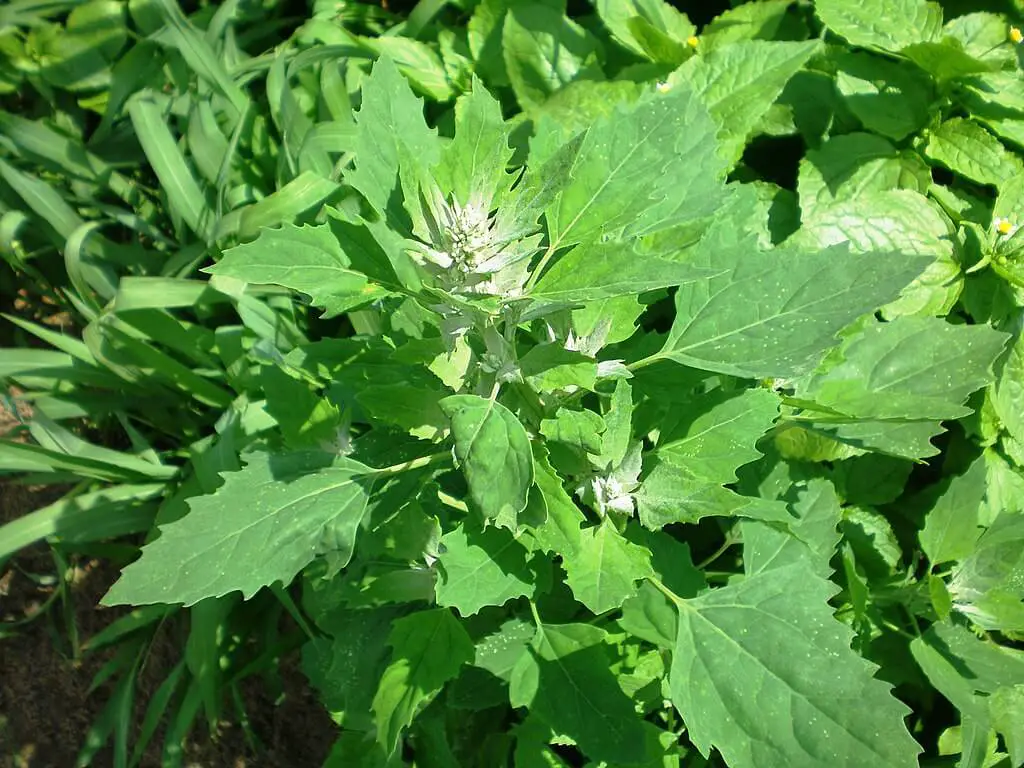
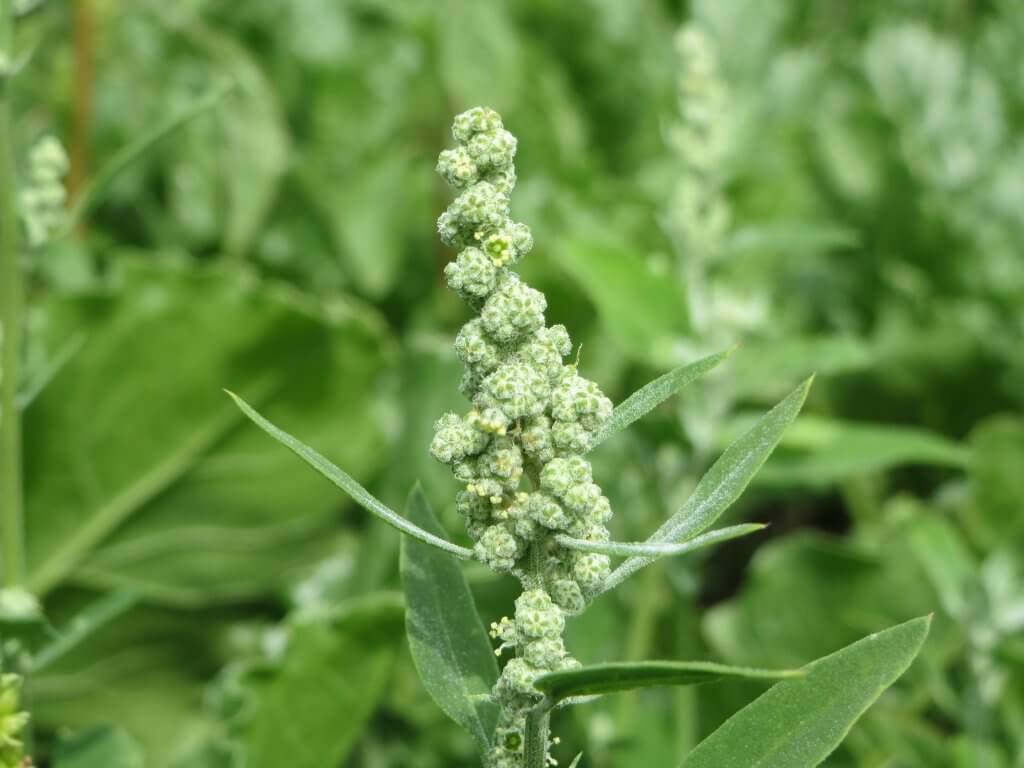

Where is Lamb’s quarters found?
This wild edible is native to North America and is commonly found throughout the United States and Canada.
Lamb’s quarters is highly adaptable and can grow in a range of habitats, including gardens, agricultural fields, roadsides, waste areas, and disturbed sites. It often thrives in nutrient-rich soils and areas that have been recently disturbed or cultivated.
Is lamb’s quarters poisonous?
Lamb’s quarters is not considered poisonous, and it is actually edible and nutritious.
What part of lamb’s quarters do you eat?
The young leaves of lamb’s quarters are the most commonly consumed part of the plant and can be eater raw or cooked. Older leaves benefit from cooking methods that help soften their texture and mellow their flavor.
It’s important to note that while the leaves are the primary edible part of lamb’s quarters, other parts of the plant (such as the seeds) are also edible.
Lamb’s quarters seeds can be prepared similarly to other grains or seeds. They have a nutty flavor that can add variety to your meals.
Can you eat lamb’s quarters raw?
Yes, you can eat lamb’s quarters raw. The young leaves of lamb’s quarters are edible and can be consumed raw, much like other leafy greens.
In fact, lamb’s quarters leaves are often used in salads and other dishes without any cooking.
Make sure to also check our articles on other wild edible plants including:
What does lamb’s quarters taste like?
Lamb’s quarters’ leaves have a flavor that is often compared to spinach.
The flavor of lamb’s quarters is generally mild and slightly earthy. It has a pleasant and subtle taste that is not overpowering.
How do you prepare lamb’s quarters?
Our favorite methods for preparing and cooking lamb’s quarters:
Salads: Simply tear or chop the leaves and combine them with other salad ingredients like vegetables, nuts, seeds, and dressings.
Sautéed or Stir-Fried: Sautéing lamb’s quarters is a popular method that brings out its flavor and reduces its volume. Here’s how:
- Heat a pan over medium heat and add a bit of oil (olive oil, butter, or your preferred cooking oil).
- Add chopped garlic or onions if desired, and sauté for a minute.
- Add the cleaned lamb’s quarters leaves to the pan and sauté for a few minutes until they wilt and become tender.
- Season with salt, pepper, and any other herbs or spices you prefer.
Blanched: Blanching is a quick cooking method that helps retain the vibrant color of the leaves. Here’s how:
- Bring a pot of water to a boil and prepare a bowl of ice water.
- Submerge the lamb’s quarters leaves in the boiling water for about 1-2 minutes.
- Remove the leaves and immediately transfer them to the bowl of ice water to stop the cooking process.
- Drain and use in your desired dishes.
Added to Soups and Stews: Lamb’s quarters can be added to soups, stews, and other cooked dishes. Add them toward the end of the cooking process to prevent overcooking.
Smoothies: For a nutritious boost, add raw lamb’s quarters leaves to your smoothies. Their mild flavor blends well with fruit flavors.
Omelets and Frittatas: Add chopped lamb’s quarters to omelets, scrambled eggs, or frittatas for added flavor and nutrition.
Pestos: Using lamb’s quarters leaves as the base, you can create a flavorful pesto that can be used in a variety of dishes.
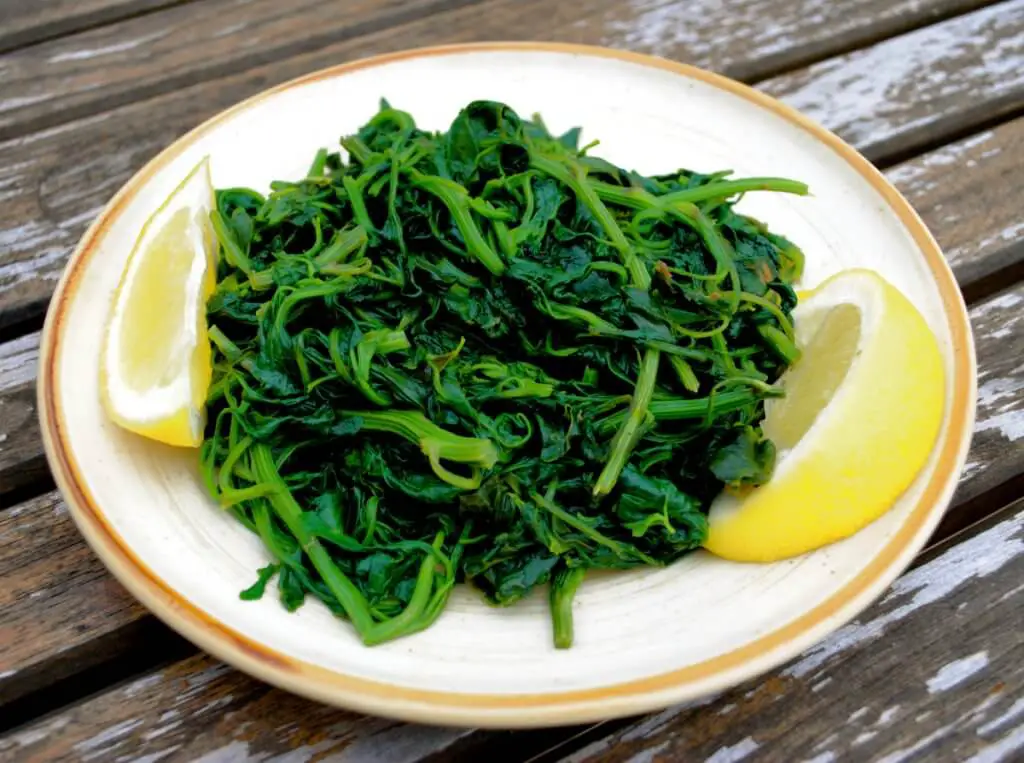

What is the nutritional value of lamb’s quarters?
Nutrients per 100 grams of raw lamb’s quarters leaves:
- Calories: Approximately 23 calories
- Carbohydrates: About 4.2 grams
- Protein: Roughly 2.7 grams
- Dietary Fiber: Around 2.8 grams
Lamb’s quarters also provide a variety of vitamins and minerals, including:
- Vitamin A
- Vitamin C
- Vitamin K
- Calcium
- Magnesium
- Iron
- Potassium
What is the difference between lamb’s quarters and quinoa?
Lamb’s quarters and quinoa (Chenopodium quinoa) are related plants that belong to the same botanical family, Amaranthaceae.
Lamb’s quarters is an annual herbaceous plant with triangular to diamond-shaped leaves that are often gray-green on the underside. The leaves are the part most commonly consumed and have a mealy texture and a mild flavor.
Quinoa is characterized by its tall, slender stalks that produce clusters of small flowers. Its seeds are the edible part of the quinoa plant and are covered by a saponin-rich coating that needs to be removed before consumption.
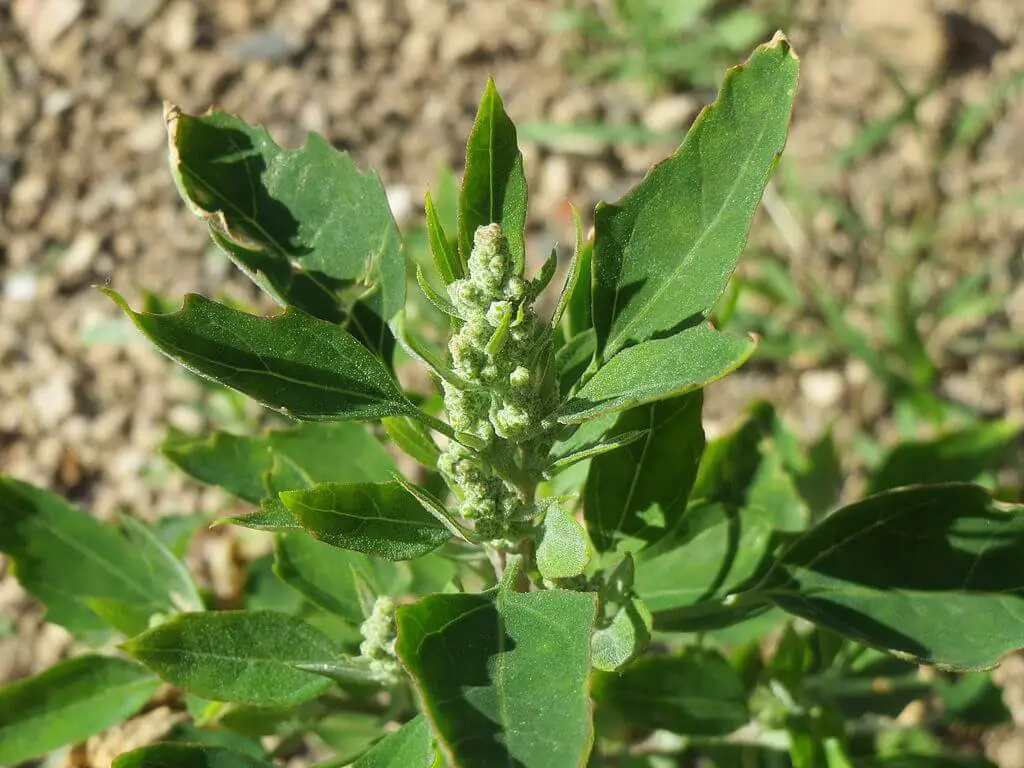
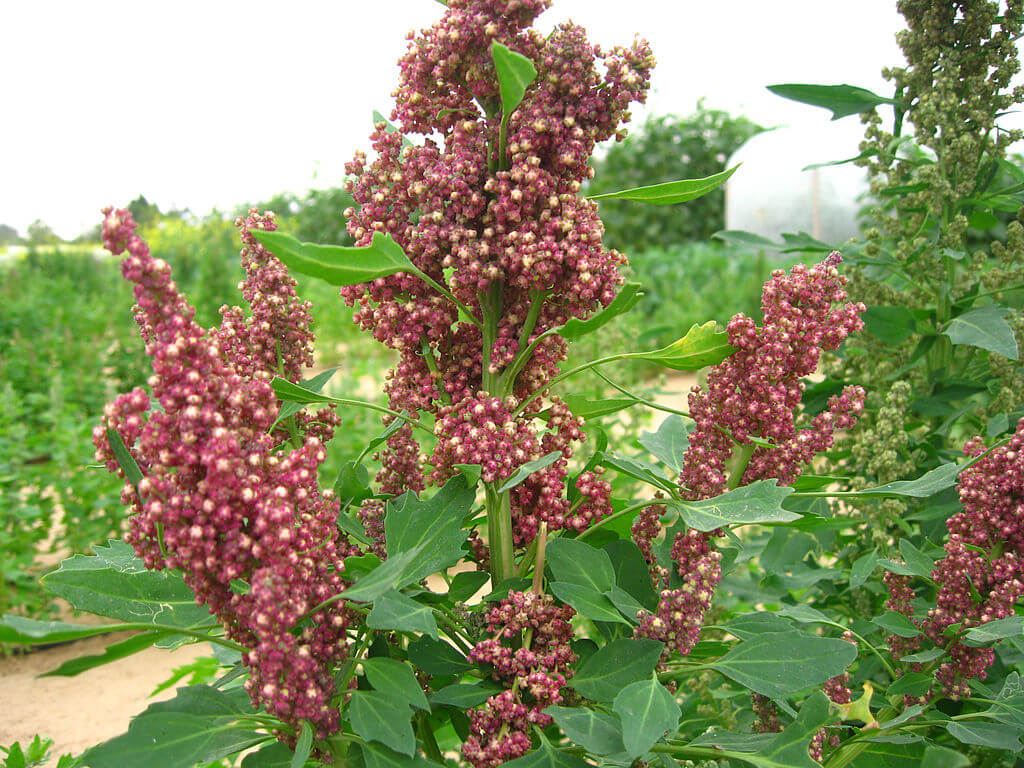
Where & When to Forage for lamb’s quarters
Where to Forage
Lamb’s quarters is a widespread plant and can be found in various North American regions. It can grow in various climate zones, so you might find it in both northern and southern states.
It’s considered a common weed and is often found in disturbed areas, gardens, fields, and roadsides.
When to Forage
- Spring: In the spring, young lamb’s quarters leaves start emerging. These tender leaves are often considered the best for consumption due to their milder flavor and texture.
- Summer: You can continue to forage for lamb’s quarters during the summer months. However, as the plant matures, the leaves can become tougher and develop a stronger taste.
- Fall: Some regions experience a second growth of lamb’s quarters in the fall, providing another opportunity to forage for fresh leaves.
What to read next: Eating Your Way Through Different Edible Goosefoot Plants
Ana has always been interested in all things nature and flora. With her expertise in home gardening and interest in foraging, she has been spending her weekends and free time looking for edible native plants, flowers, and fungi. One of her many hobbies includes testing new savory and sweet recipes, juices or teas made from freshly picked plants, wild fruits, or mushrooms.

